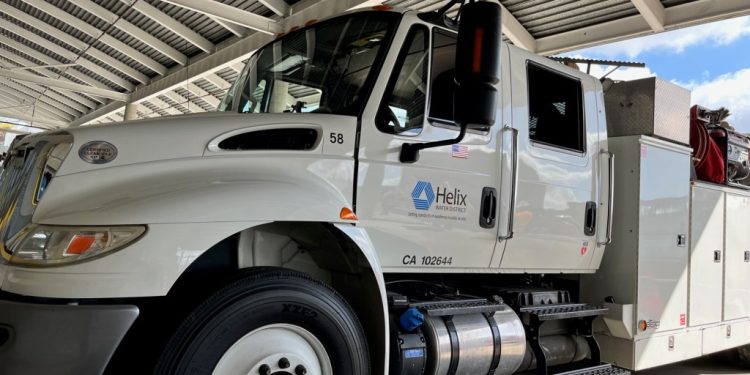Many know the Edict of California that by 2035, sales of all new passenger vehicles in the State must be zero-emission.
What is less known is that state regulations also require that state and local agencies to reach the goal at a much faster rate. According to California Air Resources Board regulations, 100% of the purchases of new average and heavy vehicles for government fleets must be zero issues from January 1, 2027.
In this spirit, the construction teams were busy digging trenches and doing other renovation work at the Helic district operations center in El Cajon on Friday morning.
The public utility which distributes water to 278,000 people in the suburbs of the County of East de San Diego inaugurated a project of $ 11 million which will install infrastructure – such as the charging stations – which will help public service transition its fleet to zero emission vehicles.
“The $ 11 million includes the design of engineering, construction costs and the acquisition of all materials”, such as the charge units, said Kevin Miller, director of operations in the propeller district. “We also have available funding to set up a software solution to execute the system essentially.”
The construction should be completed by the end of the first quarter of next year.
The current water district fleet includes 86 medium and heavy vehicles that operate on renewable diesel fuel or fuel, 10 fully electrical Lightning Fordning Fordning trucks and eight rechargeable hybrids.
The public service will not immediately go to a fleet made up of zero emission vehicles. Instead, like each car truck and internal combustion service reaches the end of its useful lifespan, it will be replaced by a vehicle which responds to the mandate of the State.
With the help of the software system, the load of electric vehicles of the fleet will be coordinated to ensure that the Water Helix district can maintain the same amount of reliability that it currently has with its diesel and gas vehicles.
“We are a 24/7, 365 (days a year) response agency,” said Miller. “So, if we have a main break (of water) in the middle of the night or any urgency of water, we must have all our equipment loaded and ready to leave.”
A price of $ 11 million is heavy, but the cost has been widely hit by several subsidies obtained by the officials of the water district.
Helix received $ 5.2 million from the atmospheric pollution control district of San Diego, a $ 2.2 million subsidy from San Diego Gas & Electric’s Power Program Drive for Fush and 1.5 million dollars through the Disadvised Electric Electric Vehicle Charters Program.
The water district could also hang a subsidy of $ 750,000 from California Energy Commission. “We still have things to submit on this subject, but it seems promising,” said installation director Joe Garuba.
The balance will be funded by Helix, but Miller said: “Because we have obtained funding for grants with our partners, we are able to keep our prices stable and this burden is not transmitted to taxpayers themselves.”
The $ 11 million project does not include the purchase cost of electric vehicles which are gradually based in the propeller fleet.
Zero emission vehicles have higher sticker prices than cars and trucks with internal combustion engines, but propeller officials think that at the long term, the costs for taxpayers will even be released.
First, they provide lower maintenance costs with electric vehicles compared to conventional vehicles. Second, the water district said that going electric, it can avoid volatility in fuel prices.
“It is not uncommon to see swings of 25% to 30% during the year in fuel pricing,” said Garuba. “The electric prices are much more stable … If you look at this cradle at a serious approach to the cost of possession, it really withdraws.”

Once the project is completed, Helix will share its load infrastructure with neighboring agencies which must also transition their fleets to respond to the mandate of the State, such as the County of San Diego, the cities of San Diego and El Cajon, and the water districts of Otay, Sweetwater and Lakeside.
“It makes sense from a regional point of view, when you look at how to do a settlement like this,” said Miller. “We can’t look at this myopic. We have to look at the overview.”
When these agencies use the Helix infrastructure, they must reimburse the cost of the electricity they use.
“If they connect, they will pay for it,” said Miller. “So our taxpayers will not cover electrical requests from other entities.”
The Helix Water district distributes water to Mesa, El Cajon, Lemon Grove, Spring Valley customers and other areas not constituted in San Diego County Society. It maintains 742 miles of pipelines, valves, fire terminals and meters.
The EV infrastructure project was approved during a 5-0 vote by the Board of Directors of the Water District, which are elected.
“This project will be a model for other agencies that work to electrify their fleets and to help the cities that we serve to achieve their objectives of climate action plan,” said Dan McMillan, Chairman of the Board of Directors of the Water District, in a press release.
Originally published:
California Daily Newspapers


